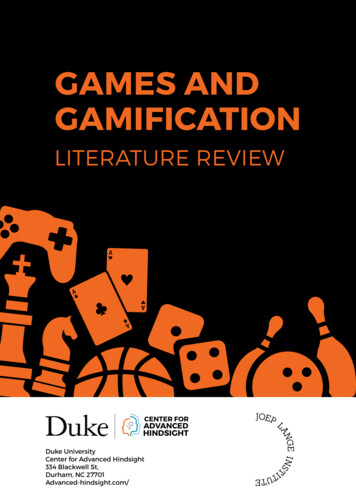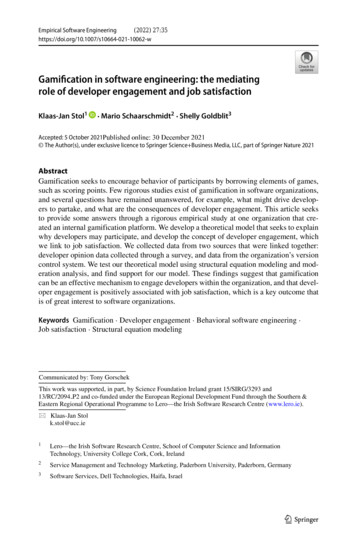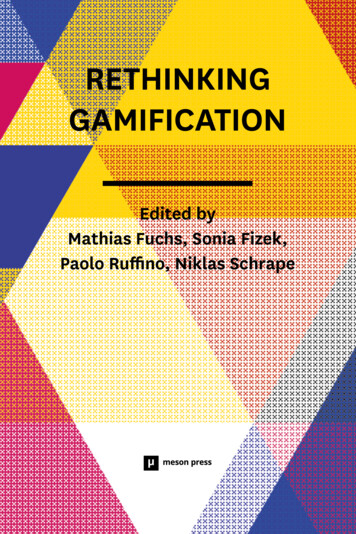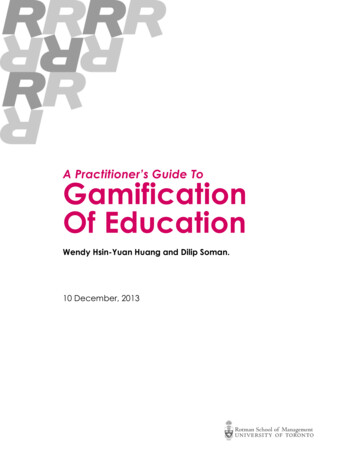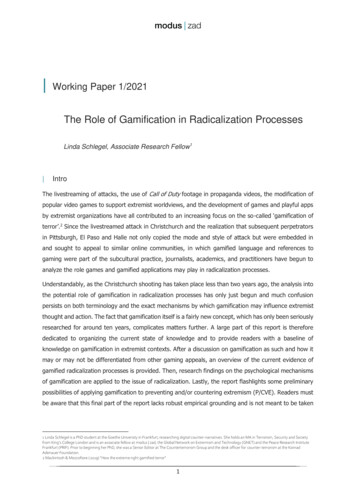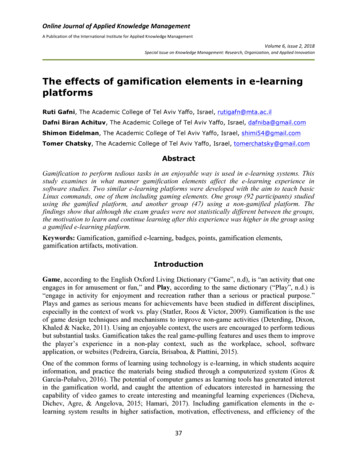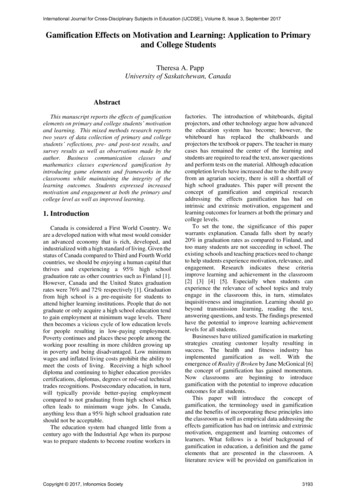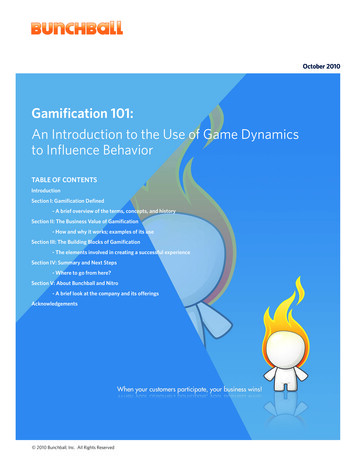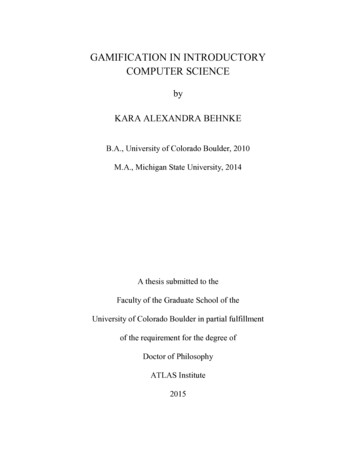
Transcription
GAMIFICATION IN INTRODUCTORYCOMPUTER SCIENCEbyKARA ALEXANDRA BEHNKEB.A., University of Colorado Boulder, 2010M.A., Michigan State University, 2014A thesis submitted to theFaculty of the Graduate School of theUniversity of Colorado Boulder in partial fulfillmentof the requirement for the degree ofDoctor of PhilosophyATLAS Institute2015
This thesis entitled:Gamification in Introductory Computer Sciencewritten by Kara Alexandra Behnkehas been approved for the ATLAS InstituteJohn K. BennettDirk GrunwaldClayton LewisJane PreyDoug C. SickerDiane E. SieberDateThe final copy of this thesis has been examined by the signatories, and wefind that both the content and the form meet acceptable presentation standardsof scholarly work in the above mentioned discipline.IRB protocol # 15-0018IRB protocol # 15-0119
Behnke, Kara Alexandra (Ph.D., ATLAS Institute)Gamification in Introductory Computer ScienceThesis directed by Archuleta Professor of Computer Science and Professor of Electrical andComputer Engineering Dr. John K. BennettThis thesis investigates the impact of gamification on student motivation and learning inseveral introductory computer science educational activities. The use of game design techniquesin education offers the potential to make learning more motivating and more enjoyable forstudents. However, the design, implementation, and evaluation of game elements that actuallyrealize this promise remains a largely unmet challenge. This research examines whether theintroduction of game elements into curriculum positively impacts student motivation and intendedlearning outcomes for entry-level computer science education in four settings that apply similargame design techniques in different introductory computer science educational settings. Theresults of these studies are evaluated using mixed methods to compare the effects of game elementson student motivation and learning in both formal and non-formal learning environments.The first chapter of this thesis introduces the focus of the research. The second chapterdiscusses the related work on introductory computer science education and gaming culture. Thethird chapter introduces the conceptual and theoretical framework that forms the basis of this work.Chapter four introduces the research design. Chapter five presents the first case study, whichinvestigated how a “gamified” class impacts student motivation and learning outcomes in anundergraduate computer science course. Chapter six discusses the second case study, whichexamined how the design techniques informed by the first case study support high school studentslearning introductory computer science in an extracurricular program. Chapter seven details thethird case study, which examined how game elements influence children learning in a roboticsworkshop. Chapter eight discusses the final case study, which briefly examined how onlinetutorial websites facilitate introductory programming through gaming.The final chaptersummarizes the key findings and discusses opportunities for future work in gamifying computerscience education.iii
ACKNOWLEDGEMENTSI am grateful for my advisor, Dr. John K. Bennett, who first believed in my ability. I am profoundlythankful for all my committee members: Dr. Diane Sieber for her insight in gaming and passionfor the humanities in engineering; Dr. Clayton Lewis, whose work in both teaching and researchcontinues to inspire me in all my academic endeavors; Dr. Dirk Grunwald, who helped connectme to the computer science education committee both in Boulder, CO and abroad; Dr. DougSicker, for the invigorating talks about policy and technology; and Dr. Jane Prey, your work atboth the National Science Foundation and Microsoft Research is something I aspire for in myprofessional ambitions. Thanks to each of you for helping me accomplish the most challengingtask I have ever sought out to do.I would not be who I am today, nor made it through this doctoral journey, without my ChosenFamily. Zander, my husband and life partner, whose love, encouragement, and groundedreassurance helped me pull myself through many tough times. Dan, who has helped me grow inmore ways than I thought possible, and for helping me manage my data. Julia, experiencing thisacademic journey alongside your own has been a privilege in its own right. Thank you to myConsigli and Behnke families for many happy memories and much needed home-cooked meals.My gratitude for the ATLAS Institute and its community are beyond words. I never felt that I fitin anywhere academically or professionally until I found this inspiring community of creative,talented, fantastic misfits. I want to especially thank Brittany Ann Kos, the best TA and secondcoder I could have hoped for. Special thanks to Dr. Meg Ambrose, Dr. Katherine Goodman, Dr.Joanne White, Dr. Leslie Dodson, and Dr. Heather Underwood, who each in turn inspired andencouraged me throughout this process.I would also like to thank the National Science Foundation GK-12 ECSITE Program, who offeredme the graduate funding and professional support to help me finish my doctorate. Special thanksto Jessica Feld, Dr. Debra Goldberg, the other ECISTE Fellows, and the magnificent high schoolteachers I worked with during my time as a Fellow—I learned more about teaching students andteaching computer science than I could have imagined.Thank you to everyone who helped make this journey become an “Epic Win!”iv
CONTENTSCHAPTER I . 1INTRODUCTION . 1I. BACKGROUND AND MOTIVATION. 1II. PRIOR RESEARCH . 3III. RESEARCH GOALS . 7IV. METHODS . 8CHAPTER II . 11RELATED WORK . 11I. INTRODUCTORY COMPUTER SCIENCE EDUCATION. 11II. GAMING: BEYOND ENTERTAINMENT . 23CHAPTER III THEORETICAL FRAMEWORK . 34A. SELF-DETERMINATION THEORY . 34CHAPTER IV RESEARCH DESIGN & METHODOLOGY . 45I. RESEARCH STRATEGY . 45II. THEORETICAL DESIGN . 49III. MIXED METHODS . 54CHAPTER V CASE STUDY ONE: VIRTUAL WORLDS . 62I. SITE SELECTION . 62II. RESEARCH DESIGN . 63IV. IMPLEMENTATION . 70V. INSTRUMENTATION & EVALUATION . 100VI. CASE STUDY ONE FINDINGS . 103VII. DISCUSSION . 166v
VIII. CONCLUSIONS AND FUTURE WORK . 169CHAPTER VI CASE STUDY TWO: TECHNOVATION . 171I. SITE SELECTION . 172II. RESEARCH DESIGN . 173III. IMPLEMENTATION. 175IV. EVALUATION . 185V. FINDINGS . 187VI. DISCUSSION . 196IX. FUTURE WORK . 198CHAPTER VII CASE STUDY THREE: CODERDOJO . 200I. RESEARCH SITE. 200II. RESEARCH DESIGN . 202III. EVALUATION . 216IV. FINDINGS . 220V. DISCUSSION. 224CHAPTER VIII CASE STUDY FOUR: ONLINE TUTORIALS. 226I. RESEARCH SITE. 227VI. RESEARCH DESIGN. 232VII. EVALUATION . 235VIII. FINDINGS . 235X. DISCUSSION. 244XI. FUTURE WORK . 246CHAPTER IX CONCLUSIONS & FUTURE WORK . 247I. RESEARCH SUMMARY . 247vi
II. SUMMARY OF FINDINGS . 248III. FUTURE WORK . 249vii
LIST OF TABLESTable 1. Summary of Case Study Methodology 9Table 2. AP Computer Science A vs. AP Computer Science Principles Curricula .18Table 3. The CS Principles Six Computational Thinking Practices 19Table 4. The CS Principles Seven Big Ideas 20Table 5. Null and Alternative Hypothesis .46Table 6. Summary of CSTA Standards Curriculum Levels per Case Study .50Table 7. Non-randomized Treatment for Proxy Pre-Test & Post-Test 63Table 8. Summary of CS Principles Instantiated via SDT .74Table 9. Course Objectives for ATLS/CSCI-1220 .76Table 10. Required Quests/Labs (Except Bonus Round/Extra Credit) 79Table 11. Case Study One Proxy Pre-Test Itemization .101Table 12. Case Study One Post-Test Itemization 102Table 13. Chi-Square test of Male/Female Gamers & Non-Gamers .115Table 14. Mann-Whitney U Results (p 0.05) .119Table 15. Major Categories and Emergent Codes for Midterm Evaluation Survey .121Table 16. Summary of Coding Scheme per Group (n 80) .122Table 17. t-Test for Variable Group Pre-Test (Q20) and Post-Test (Q34) where p 0.05 .125Table 18. t-Test for Control Group Pre-Test (Q20) and Post-Test (Q34) where p 0.05 .127Table 19. t-Test for Variable Group Pre-Test (Q19) and Post-Test (Q33) where p 0.05 .137Table 20. t-Test for Control Group Pre-Test (Q19) and Post-Test (Q33) where p 0.05 .138Table 21. t-Test for Variable Group Pre-Test (Q13) and Post-Test (Q35) where p 0.05 .142Table 22. t-Test for Control Group Pre-Test (Q13) and Post-Test (Q35) where p 0.05 . 143Table 23. Comparison of Technovation Objectives & CSTA Strands . 176Table 24. Technovation Course Curriculum and Weekly Lessons . .177Table 25. Summary of Successful Pre-Test & Post-Test Learning Outcomes .189Table 26. CoderDojo Curriculum Goals & Associating Computational Thinking Practices .204Table 27. Workshop Learning Objectives & Associating Big Ideas .206Table 28. Itemized Learning Outcomes for Pre- and Post-Tests .219Table 29. Pre-Test & Post-Test t-Test of Mean Scores where p 0.05 222Table 30. List of Online Tutorial Websites and Instructional Approaches . .230Table 31. Pre-Test & Post-Test t-Test of Mean Scores where p 0.05 244viii
LIST OF FIGURESFigure 1. Gender Representation of Variable Group (left) & Control Group (right) .67Figure 2. Ethnic & Racial Distribution in Variable Group .68Figure 3. Ethnic and Racial Distribution in Control Group .68Figure 4. Student Enrollment in Variable (left) & Control (right) Groups .69Figure 5. Screenshots of the Virtual Worlds Course Homepage .71Figure 6. Gamified Course Objectives (Variable Group) .72Figure 7. Traditional Course Objectives (Control Group) 73Figure 8. Syllabus Policies & Assessment .83Figure 9. Daily Class Schedule (Control Group) .84Figure 10. Roadmap for Missions & Quests (Variable Group) .85Figure 11. Example of Quest/Lab Objective . .86Figure 12. Scaffolding Learning via Quests/Labs 87Figure 13. Provided “Hints” & Submission Requirements .88Figure 14. Feedback-loop for Abstracting Mission .90Figure 15. Feedback-loops for the Abstracting Mission (left) & CS Principle (right) .91Figure 16. Earned Badges for the Abstracting Mission . .92Figure 17. Displayed Badges on Profile Page .93Figure 18. Leaderboard Rank for Variable Group 95Figure 19. Badge Awarded to Students Who Fail a Quiz .96Figure 20. Student Profile & Activity Stream .98Figure 21. Screenshot of Forums (Variable Group) .99Figure 22. Item Q50: 61% Approve of Gaming Metaphors 106Figure 23. Summary of Responses to Item Q54 in the Variable Group .108Figure 24. Summary of Responses to Item Q57 in the Variable Group .109Figure 25. Summary of Responses to Item Q47 in the Variable Group .110Figure 26. Summary of Leaderboard Attitudes for Q52, Q53, and Q56 .112Figure 27. Summary of Q21 Results: Participants’ Overall Gaming Habits .114Figure 28. Summary of Q25 Results: Self-Identified Gamers .114Figure 29. Course Grade Breakdown for Variable Group (left) and Control Group (Right) .118Figure 30. Total Grade Summary Variable and Control Groups .118Figure 31. Summary of Q43 Responses for Variable & Control Group .120Figure 32. Pre-Test & Post-Test Comparison of Student Interest in CS (Variable Group) 124ix
Figure 33. Pre-Test & Post-Test Comparison of Student Interest in CS (Control Group) .126Figure 34. FCQ “How Much [was] Learned” between Variable (left) & Control (right) Groups .130Figure 35. Summary of Q37 for Variable Group (Left) and Control Group (Right) .131Figure 36. Summary of Q39 for Variable Group (Left) and Control Group (Right) .132Figure 37: Course Rating via FCQs for Variable (left) & Control (right) Groups .134Figure 38. Average Ratings between Variable (left) & Control (right) Groups .135Figure 39. Pre-Test (Q19) & Post-Test (Q33) of Programming Skills (Variable Group) .136Figure 40. Pre-Test (Q19) & Post-Test (Q33) of Programming Skills (Control Group) 138Figure 41. Pre-Test (Q13) & Post-Test (Q35) for CS as a Creative Practice (Variable Group) .141Figure 42. Pre-Test (Q13) & Post-Test (Q35) for CS as a Creative Practice (Control Group) .142Figure 43. Total Item Responses for Q63 for Variable Group (left) & Control Group (right) .146Figure 44. Total Item Responses for Q64 for Variable Group (left) & Control Group (right) .147Figure 45. Total Item Responses for Q1-Q3 for One Year Follow-Up Survey .149Figure 46. Total Item Responses for Q5-Q8 for One Year Follow-Up Survey . .154Figure 47. Summary of Q45 Responses for Variable & Control Group .161Figure 48. App Inventor’s Block-Programming Environment .178Figure 49. Example Lesson Strategy for Technovation .179Figure 50. Homepage of Gamified Technovation Website .181Figure 51. Feedback-loop for Completing Unit Lessons 182Figure 52. Secondary Feedback-lop via the Website .182Figure 53. Technovation Members List .183Figure 54. Example of Student Workbook Unit (Hardcopy) .184Figure 55. Example of Student Workbook Unit via Website .185Figure 56. The Technovation Classroom .191Figure 57. Photograph of the 2nd Gamification Iteration 192Figure 58. The Cubelets Six Kit .203Figure 59. The Robot Investigator Mission Log .207Figure 60. Learning Objectives via the Robot Investigator Workbook .208Figure 61. Mission Objective for Day 1 .209Figure 62. Daily Missions & Objectives are Color-Coded .211Figure 63. Red Text Signifies Opportunities to Earn Badges .213Figure 64. The “Badges Plaque” to Display Earned Badges .215Figure 65. Day 4: Build a Robot to Escape the Maze .217Figure 66. Smileyometer (Sluis, Dijik, & Perloy, 2012) as a Visual Aid for Likert Scaling .219x
Figure 67. Photograph of Children Engaging in Constructionism via Cubelets .223Figure 68. Screenshot of the Gidget (2014) Game-Based Learning Environment .227Figure 69. Screenshots of Khan Academy’s Gamification (left) & Programming Editor (right) .228Figure 70. Screenshots of Grok Learning Programming Console .229Figure 71. Screenshots of CS1 Knowledge Assessment Items .234Figure 72. Responses to Post-Test Q6-Q89 for Gidget .236Figure 73. Responses to Post-Test Q13-Q16 for Khan Academy .238Figure 74. Summary of Intrinsic Motivation Responses of Students from SIMS .241Figure 75. Summary of Identified Regulation Responses of Students from SIMS .242Figure 76. Summary of External Regulation Responses of Students from SIMS .243Figure 77. Summary of Amotivation Responses of Students from SIMS .243xi
CHAPTER IINTRODUCTIONI.BACKGROUND AND MOTIVATIONInformation and communication technologies have profoundly altered interaction inhuman society, productivity in enterprise, and the creation and dissemination of information (NRC,2003; NRC 2005; NRC, 2007). The use of modeling and simulation, visualization, and themanagement of massive data sets have fostered computer science as a bridge between science,technology, engineering, and mathematics (STEM) disciplines. Computer science (CS) hasenabled significant advances in innovation and imagination, and continues to facilitate efforts toaddress many social problems.Although the United States has become increasingly dependent upon information andcommunication technologies, many of its citizens are ill-equipped to make informed decisionsabout technology (NRC, 2005), and also lack the knowledge and capability to take advantage ofthe many opportunities emerging from technological and social change (NRC, 2005; Owens &Stephenson, 2011). Professionals in every discipline—art and entertainment, communications andhealth care, government infrastructure and economic exchange—need to understand and be ableto employ computing in order to function and thrive in a globally competitive environment (NRC,2007). Without meaningful engagement and facility with computer science by the general public,the U.S. economy risks losing competency and self-efficacy in the global networked age (NRC,2007; NRC, 2005).Many jobs that today’s students will have during their careers have not yet been invented,and the majority of careers in the 21st century will require some background in computer science1
(Owens & Stephenson, 2011; NRC, 2007). The U.S. Bureau of Labor Statistics (2013) estimatesthat between 2010 and 2020 approximately 1.4 million computing-related jobs will be created inthe U.S. alone. Even though the computing industry has more projected career growth than allother jobs combined, including all STEM careers (Bureau of Labor Statistics, 2013), less than2.4% of college students graduate with a degree in computer science. Even though undergraduatestudent enrollment in computer science has increased slightly over the last few years, CS as a fieldof study historically has high attrition rates, and in some cases, negative growth for non-majoritygroups (ACM & IEEE, 2013). Diversity is critical to innovation and excellence (NRC, 2005;NRC, 2007); thus increasing diversity is key to long-term economic growth and globalcompetitiveness (NRC, 2003; NRC 2005; NRC, 2007). However, only 26% of the computingworkforce are women, and less than 4% of the computing workforce are Latina or AfricanAmerican women (NCWIT, 2015).Therefore, a basic understanding of and facility withcomputational thinking (Wing, 2009), computing literacy, and computer science is essential tobeing part of a well-educated and informed citizenry in the twenty-first century (NRC, 2004; NRC,2007). As the Information Age continues to transform virtually every aspect of life, computerscience must become part of a general liberal education. The required understanding of computingis deeper than the ability to use a computer or a mobile phone for day-to-day personal productivityor social interaction.How should we teach students computer science skills? Seymour Papert (1971; 1980)argued that learning computer science is a way of learning about learning. Computer science canhelp individuals learn how to think critically and creatively (Owens & Stephenson, 2011; NRC,2003); how to approach ambiguous and challenging problems (ACM & IEEE, 2013); how toanalyze and synthesize vast amounts of information (NRC, 2003); how to use computation as an2
analysis tool (NRC, 2007; Wing, 2009); how to understand relationships between seeminglydisparate data (NRC, 2007); and how to collaborate (NRC, 2005). Learning computer science thusaffords individuals the ability to navigate more effectively through a society in which theyfrequently encounter technology in their personal lives (NRC, 2010). Why then, do so few studentspursue studies in this critically important field?II.PRIOR RESEARCHCollege and high school curricula have struggled to provide students with engagingmethods for learning both basic and advanced computational concepts, and efforts to incorporatecomputer science into K-12 curricula have met with limited success. Only twenty-seven states inthe U.S. allow students to count computer science courses towards high school graduation(Association of Computing Machinery, 2011). Moreover, the majority of schools in the U.S. donot even offer computer programming classes (Association of Computing Machinery, 2011;Gallup, 2014). When courses are offered, many students, particularly female students and thosefrom underrepresented minority groups, are choosing not enroll in CS classes (ACM & IEEE,2013). Although the number of students taking Advanced Placement (AP) CS courses hasincreased in recent years (Ericson & Guzdial, 2014), the number of students taking thisexamination is much smaller than for other AP STEM Examinations. For example, of the1,379,585 AP math and science exams taken by U.S. high school students in 2013, only 29,555were computer science exams—a 2:98 ratio of students in computer science relative to the rest ofSTEM. In addition, the participation rate of underrepresented groups in AP computer science,including female, African American, and Latina students, is also lower than other STEM AP3
examinations1. Ericson and Guzdial (2014) argue, “If you want more AP CS exam-takers, thefocus should be on the underrepresented groups” (p. 222). Issues of privileged access may beanother reason why non-majority populations continue to have low representations in thecomputing workforce (NCWIT, 2015). The low participation of students, particularly nonmajority groups, in the Advanced Placement Computer Science curriculum is emblematic of thisproblem.Many students, particularly girls and women, find traditional approaches for learningcomputer science off-putting, asocial, and boring (AAUW, 2000; Margolis & Fisher, 2002;Ashcraft et al., 2012). How best to teach introductory computer science on a broad level,particularly for those with limited exposure or no previous experience in CS, remains a significantchallenge. Since many young people are actively engaged in digital gaming2 spaces (Van Eck,2006; Kafai et al., 2008; ESA, 2014) and video games3 themselves are computational artifacts,digital gaming offers a potentially promising approach to increase student interest and engagementfor learning computer science.There have been numerous efforts to translate the engagement found in games intoeducation (Ritzhaupt, 2009; Linhoff & Settle, 2009; Barnes, Richter & Powell, 2007; Eagle &Barnes, 2009; Cooper, Dann, & Pausch, 2003; Malan & Leitner, 2007; Basawapatna, Koh &Repenning, 2010). Many argue that games embody beneficial learning principles (Malone, 1980a,1980b; Shaffer, 2008; Collins & Halverson, 2009; Gee, 2003; Squire, 2011, 2003) by promoting1In 2012, AP Calculus had a higher percentage of underrepresented groups take the exam than CS: for females48.3% (Calculus) versus 18.7% (CS), for African American students 5.4% versus 4.0%, and Latina students 11.5%versus 7.7% (Arpaci-Dusseau et al., 2013).2Digital gaming refers to video games, computer games, mobile hand-held games, social-media games, etc.3I use video games, gaming, and games interchangeably to denote the broader pop-cultural applications of all digitalgaming spaces, since the vernacular of “video games” is often used to describe this phenomenon.4
extrinsic and intrinsic motivations (Schmitz et al., 2011), allowing the freedom to explore and fail(Mitgutsch, 2012; Malaby, 2007), and fostering effective problem-solving skills (Squire et al.,2008; Gee, 2003; Bogost, 2007; Khaled et al., 2009).Despite the numerous attempts to use games in education, these efforts have yielded onlymixed results (Charsky, 2010; Van Eck, 2006). Many game designers and educators haveattempted to harness the power of games for learning, but these efforts have often resulted in boringgames with ineffective learning (Papert, 1980; Mitgutsch & Alvarado, 2012). As Bogost (2011)succinctly states: “Making games is hard. Making good games is even harder. Making good gamesthat hope to serve some external purpose is even harder” (p. 3). Some studies have made progressin developing methodologies for designing games that obtain or retain the player’s engagement,while also achieving some expli
Gamification in Introductory Computer Science Thesis directed by Archuleta Professor of Computer Science and Professor of Electrical and Computer Engineering Dr. John K. Bennett This thesis investigates the impact of gamification on student motivation and learning in seve
